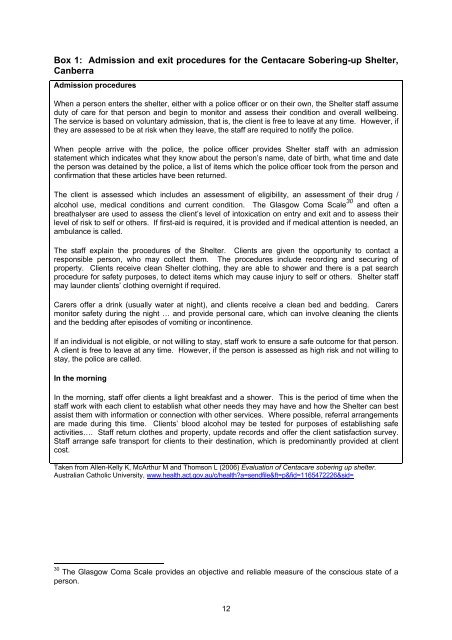Services that Manage the Care Needs of Drunk - Scottish Government
Services that Manage the Care Needs of Drunk - Scottish Government
Services that Manage the Care Needs of Drunk - Scottish Government
You also want an ePaper? Increase the reach of your titles
YUMPU automatically turns print PDFs into web optimized ePapers that Google loves.
Box 1: Admission and exit procedures for <strong>the</strong> Centacare Sobering-up Shelter,<br />
Canberra<br />
Admission procedures<br />
When a person enters <strong>the</strong> shelter, ei<strong>the</strong>r with a police <strong>of</strong>ficer or on <strong>the</strong>ir own, <strong>the</strong> Shelter staff assume<br />
duty <strong>of</strong> care for <strong>that</strong> person and begin to monitor and assess <strong>the</strong>ir condition and overall wellbeing.<br />
The service is based on voluntary admission, <strong>that</strong> is, <strong>the</strong> client is free to leave at any time. However, if<br />
<strong>the</strong>y are assessed to be at risk when <strong>the</strong>y leave, <strong>the</strong> staff are required to notify <strong>the</strong> police.<br />
When people arrive with <strong>the</strong> police, <strong>the</strong> police <strong>of</strong>ficer provides Shelter staff with an admission<br />
statement which indicates what <strong>the</strong>y know about <strong>the</strong> person’s name, date <strong>of</strong> birth, what time and date<br />
<strong>the</strong> person was detained by <strong>the</strong> police, a list <strong>of</strong> items which <strong>the</strong> police <strong>of</strong>ficer took from <strong>the</strong> person and<br />
confirmation <strong>that</strong> <strong>the</strong>se articles have been returned.<br />
The client is assessed which includes an assessment <strong>of</strong> eligibility, an assessment <strong>of</strong> <strong>the</strong>ir drug /<br />
alcohol use, medical conditions and current condition. The Glasgow Coma Scale 30 and <strong>of</strong>ten a<br />
breathalyser are used to assess <strong>the</strong> client’s level <strong>of</strong> intoxication on entry and exit and to assess <strong>the</strong>ir<br />
level <strong>of</strong> risk to self or o<strong>the</strong>rs. If first-aid is required, it is provided and if medical attention is needed, an<br />
ambulance is called.<br />
The staff explain <strong>the</strong> procedures <strong>of</strong> <strong>the</strong> Shelter. Clients are given <strong>the</strong> opportunity to contact a<br />
responsible person, who may collect <strong>the</strong>m. The procedures include recording and securing <strong>of</strong><br />
property. Clients receive clean Shelter clothing, <strong>the</strong>y are able to shower and <strong>the</strong>re is a pat search<br />
procedure for safety purposes, to detect items which may cause injury to self or o<strong>the</strong>rs. Shelter staff<br />
may launder clients’ clothing overnight if required.<br />
<strong>Care</strong>rs <strong>of</strong>fer a drink (usually water at night), and clients receive a clean bed and bedding. <strong>Care</strong>rs<br />
monitor safety during <strong>the</strong> night … and provide personal care, which can involve cleaning <strong>the</strong> clients<br />
and <strong>the</strong> bedding after episodes <strong>of</strong> vomiting or incontinence.<br />
If an individual is not eligible, or not willing to stay, staff work to ensure a safe outcome for <strong>that</strong> person.<br />
A client is free to leave at any time. However, if <strong>the</strong> person is assessed as high risk and not willing to<br />
stay, <strong>the</strong> police are called.<br />
In <strong>the</strong> morning<br />
In <strong>the</strong> morning, staff <strong>of</strong>fer clients a light breakfast and a shower. This is <strong>the</strong> period <strong>of</strong> time when <strong>the</strong><br />
staff work with each client to establish what o<strong>the</strong>r needs <strong>the</strong>y may have and how <strong>the</strong> Shelter can best<br />
assist <strong>the</strong>m with information or connection with o<strong>the</strong>r services. Where possible, referral arrangements<br />
are made during this time. Clients’ blood alcohol may be tested for purposes <strong>of</strong> establishing safe<br />
activities…. Staff return clo<strong>the</strong>s and property, update records and <strong>of</strong>fer <strong>the</strong> client satisfaction survey.<br />
Staff arrange safe transport for clients to <strong>the</strong>ir destination, which is predominantly provided at client<br />
cost.<br />
Taken from Allen-Kelly K, McArthur M and Thomson L (2006) Evaluation <strong>of</strong> Centacare sobering up shelter.<br />
Australian Catholic University, www.health.act.gov.au/c/health?a=sendfile&ft=p&fid=1165472226&sid=<br />
30 The Glasgow Coma Scale provides an objective and reliable measure <strong>of</strong> <strong>the</strong> conscious state <strong>of</strong> a<br />
person.<br />
12

















